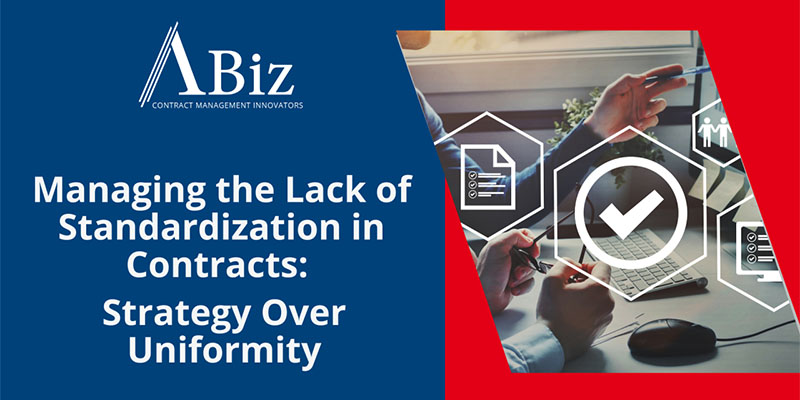“Standardization” is often treated as the holy grail of contract management, but in reality, variation is inevitable. And in many cases, it’s necessary. The challenge isn’t the presence of different contract types, templates, or terms. It’s the lack of strategic control over that variation.
As commercial and legal leaders, our objective should not be to eliminate variation at all costs. Instead, we should focus on managing it with intent. Some contracts, like NDAs or low-risk statements of work, can and should be streamlined, standardized, or even made self-service. Others, like complex licensing deals or IT services agreements, demand a more tailored approach. The key is creating a framework that distinguishes between the two and supports both with clarity, governance, and efficiency.
Why Standardization Still Matters
Contract standardization plays a vital role in business operations. When used appropriately, it can:
- Reduce legal and operational risk by using vetted language and consistent clause structures.
- Accelerate contract review and approval cycles, especially for high-volume agreements.
- Enable automation and reporting through clause tagging, metadata extraction, and AI tools.
- Streamline training and system navigation by reducing contract variation so teams can more easily find, compare, and work with familiar structures and fields across agreements.
A lack of standardization in routine or lower-risk agreements, such as NDAs or standard vendor contracts, can create unnecessary delays, invite compliance risks, and consume valuable legal and commercial resources.
Where Uniformity Can Be A Liability
Not every contract should fit the same mold. Standardization can become a liability when applied indiscriminately. Over-standardizing contracts:
- Limits flexibility in complex or high-value negotiations.
- Alienates business partners who expect tailored terms for strategic deals.
- Stifles innovation, especially in emerging or fast-moving markets.
Ultimately, contracts reflect the business relationship. When they fail to reflect the nuance of a deal, they can create friction or erode trust.
Strategic Approaches to Managing Contract Variation
Organizations should resist binary thinking (standard vs. non-standard) to manage variation effectively and adopt a more nuanced strategy that allows consistency and adaptability.
1. Segment by Risk and Frequency
Start by mapping your contract types according to their frequency and risk level.
- High-frequency / Low-Risk: These are ideal candidates for standardization and automation (e.g., NDAs, standard SOWs).
- Low frequency / High-Risk: These warrant customization and involvement from senior legal or commercial teams (e.g., IT outsourcing, licensing, M&A).
This segmentation ensures attention is directed where it matters most.
2. Tier Templates and Clause Libraries
Rather than a single rigid template, create tiers of templates that align with different contract profiles. Include fallback clauses, optional modules, and pre-approved negotiation positions. This allows teams to work faster without sacrificing control.
3. Enable Self-Service with Guardrails
Routine contracts like NDAs or DPAs can be transitioned to self-service portals with embedded approvals and e-signature workflows. This reduces reliance on Legal or Commercial teams for low-risk work and shortens turnaround times.
4. Invest in Smart CLM and AI Tools
Eliminating contract variation isn’t the only path to control; managing it intelligently is. Contract lifecycle management (CLM) systems and AI tools can bring structure to even non-standard contracts. By leveraging clause tagging, dynamic templates, metadata extraction, and AI-assisted reviews, organizations can monitor deviations, enforce policies, and gain insights across diverse contract types—without forcing everything into a single mold.
5. Establish Governance for Deviation
Standardization doesn’t mean rigidity. Implement governance models that define when and how deviations are allowed, who can approve them, and how they are tracked. This ensures flexibility is used wisely, not casually.
What Strategic Leaders Should Be Doing
Managing variation strategically starts at the top. Leaders should:
- Define contracting policies, not just templates.
- Enable operational flexibility but with controls and visibility.
- Continuously monitor contract data and usage patterns, adapting tools and guidance based on business needs.
- View contracting as a business enabler, not just a legal safeguard.
Contract management is no longer just about compliance; it’s about agility, efficiency, and enabling growth.
Conclusion: Flexibility with Purpose
Standardization is a powerful tool but should never be the end goal. Instead, organizations should strive for flexibility with purpose: standardizing where it adds value and managing variation where it’s needed.
At ABiz Corporation, we help companies develop contract strategies that balance speed with governance. Whether it’s enabling self-service for NDAs or building scalable models for complex deal negotiations, we help our clients manage contract diversity with confidence. Contact us to learn more today.
Author: Nancy Nelson, President, ABiz Corporation, Contract Management Innovators



